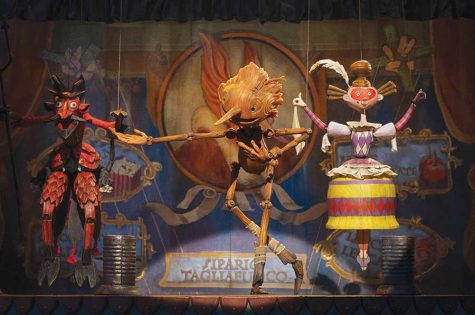“Dunkirk”: A truly human experience
On July 21, the much-anticipated World War II movie “Dunkirk” was released. It told the story of the 1940 evacuation of 400,000 trapped Allied soldiers from the beach of Dunkirk, France, after the area had become surrounded by the German army.
It is a masterpiece.
With the threat of enemy U-boats, Prime Minister Winston Churchill decided the Royal Navy couldn’t afford to send more destroyer ships to pick up soldiers and sent out a call to civilian sailors in England to aid in the evacuation. During this time, there was counter-fire by a very small squadron of Allied Spitfire planes. From May 26 to June 4, 198,000 British and 140,000 Belgian and French soldiers were evacuated.
“Dunkirk” is written and directed by Christopher Nolan, who is most famous for “Inception,” “The Dark Knight Trilogy” and “Interstellar,” all of which he has written and directed. Staying true to his rather time-warping style of directing, “Dunkirk” is not told chronologically. Rather, it is told from three different timelines following the soldiers trapped at the beach, the civilian sailors on their way to help, and the Spitfire pilots holding out for as long as they can.
It took me a little while to figure out the non-linear timing of this movie, while my 61-year-old father never caught on. It became clear to me when the soldiers trapped on the beach are experiencing night while the Spitfire pilots and sailors are still experiencing the same day. It may just be a cheap cosmetic trick to make the movie seem more extraordinary, but if it is, then I have fallen for it completely.
Hoyte Van Hoytema is the director of photography for “Dunkirk.” He has worked with Nolan before on “Interstellar,” and is also known for “Her” and the James Bond movie “Spectre.” In this movie, he switches between wide angled shots that show how many soldiers are trapped on the beach and intense close ups to accentuate the fear in the soldier’s faces. There are also panning scenic shots that swept with the Spitfires.
The score is created by Hans Zimmer, who has worked with Nolan before during “The Dark Knight Trilogy” and “Inception.” The music in “Dunkirk” definitely echoes Zimmer’s previous work in Nolan’s movies, including Zimmer’s trademark ticking, which serves as a constant reminder that time is running out.
The soundtrack features low, harrowing notes that build up suspension and create a tension that permeates every scene. Whenever conflict arises, violent violins and cellos rip through the screen and quick, harsh beats cut into my ears. Whenever there is a victory, bold horns blare. The music creates a sense of urgency so real it sent my heart racing.
It wasn’t just the music that struck a chord with me, but the sound effects as well. Without warning, there will be a barrage of bullets, a tremendous explosion, or the monstrous scream of a German Luftwaffe plane. There is never a point where I felt like I could relax and I jumped in my seat more times than I could count.
The main reason “Dunkirk” comes across as authentic is that it doesn’t sensationalize or romanticize war. The soldiers depicted are miserable and weighed down by the severity of their situations. The shock value of the movie is the sheer destruction that war creates, rather than Hollywood gore and over-the-top deaths.
The cast, including extras, totals over 6,000. Those of note are Cillian Murphey, Tom Hardy, Sir Kenneth Branagh, Mark Ryland, Fionn Whitehead and Harry Styles.
This isn’t the first time Murphey and Hardy have starred in one of Nolan’s movie; they both appeared in “Inception,” as well as “The Dark Knight Rises” as Scarecrow and Bane respectively. The two actors have also worked together on the Netflix Original “Peaky Blinders.” In “Dunkirk,” Hardy plays a Spitfire pilot battling German fighters and a depleting fuel tank. Murphey is an overwrought soldier who cracks under the trauma.
Those who remember Sir Kenneth Branagh as egotistical Gilderoy Lockhart in “Harry Potter and the Chamber of Secrets” will find his role in “Dunkirk” refreshing. Branagh, who was also in “Valkyrie,” plays a stoic commander, forced to watch his men picked off by fighter planes.
Mark Ryland plays one of the brave weekend sailors who heads into war without a second thought. He appeared in Steven Spielberg’s “Bridge of Spies” and starred in “The BFG.”
“Dunkirk” is Styles’ first movie. Before playing an attractive young soldier, Styles was famous for being in the boy band “One Direction.”
The arguable main character of the movie is another young soldier played by Whitehead. He has starred in a few projects, such as“Queers” and “The Children Act,” but “Dunkirk” seems to be his big break.
Whitehead’s acting blew me away. In the first 10 minutes of the film there is no dialog, just Whitehead running for his life and then walking aimlessly like an animal in a pen. All of the actors gave superb performances full of raw emotion.
While it’s necessary to include the cast in this review, I feel like the names of characters don’t matter. Most of them never exchange names; some don’t even have one. Instead of character development being the driving point of the movie, it’s all of their experiences as a whole that create the richness of the story. I felt for these characters not because of their backstories, of which there were none, but because they were people struggling and fighting with every ounce of their soul to survive an impossible situation. Hope and despair are in a constant battle, and it comes across the screen as something truly human.










Maureen Tobin • Oct 4, 2017 at 9:30 am
GREAT review. Not a movie that would be my first choice but after reading this article – my interest has been peaked!!!